Spatial Heterogeneity in the Determinants of Urban Form: An Analysis of Chinese Cities with a GWR Approach
Abstract
1. Introduction
2. Data and Methods
2.1. Indicators Measuring Urban Form
2.2. Influencing Factors
2.3. Geographically Weighted Regression (GWR) Modeling
3. Results
3.1. Spatial Differences of Urban Form
3.2. The Determinants of Urban Form
3.2.1. The Determinants of Urban Expansion
3.2.2. The Determinants of Urban Shape Irregularity
3.2.3. The Determinants of Urban Compactness
4. Discussion
5. Conclusion and Policy Implications
Author Contributions
Funding
Conflicts of Interest
References
- Tsai, Y.-H. Quantifying Urban Form: Compactness versus ‘Sprawl’. Urban Stud. 2005, 42, 141–161. [Google Scholar] [CrossRef]
- Clifton, K.; Ewing, R.; Knaap, G.J.; Song, Y. Quantitative analysis of urban form: A multidisciplinary review. J. Urban. Int. Res. Placemak. Urban Sustain. 2008, 1, 17–45. [Google Scholar] [CrossRef]
- Lowry, J.H.; Lowry, M.B. Comparing spatial metrics that quantify urban form. Comput. Environ. Urban Syst. 2014, 44, 59–67. [Google Scholar] [CrossRef]
- Churchman, A. Disentangling the Concept of Density. J. Plan. Lit. 1999, 13, 389–411. [Google Scholar] [CrossRef]
- Galster, G.; Hanson, R.; Ratcliffe, M.R.; Wolman, H.; Coleman, S.; Freihage, J. Wrestling Sprawl to the Ground: Defining and measuring an elusive concept. Hous. Policy Debate 2001, 12, 681–717. [Google Scholar] [CrossRef]
- Song, Y.; Knaap, G.-J. Measuring Urban Form: Is Portland Winning the War on Sprawl? J. Am. Plan. Assoc. 2004, 70, 210–225. [Google Scholar] [CrossRef]
- Mou, Y.; Song, Y.; Xu, Q.; He, Q.; Hu, A. Influence of Urban-Growth Pattern on Air Quality in China: A Study of 338 Cities. Int. J. Environ. Res. Public Health 2018, 15, 1805. [Google Scholar] [CrossRef] [PubMed]
- Holden, E. Ecological footprints and sustainable urban form. J. Hous. Built Environ. 2004, 19, 91–109. [Google Scholar] [CrossRef]
- Wang, S.; Liu, X.; Zhou, C.; Hu, J.; Ou, J. Examining the impacts of socioeconomic factors, urban form, and transportation networks on CO2 emissions in China’s megacities. Appl. Energy 2017, 185, 189–200. [Google Scholar] [CrossRef]
- Yuan, M.; Song, Y.; Hong, S.J.; Huang, Y.P. Evaluating the effects of compact growth on air quality in already-high-density cities with an integrated land use-transport-emission model: A case study of Xiamen, China. Habitat Int. 2017, 69, 37–47. [Google Scholar] [CrossRef]
- Yuan, M.; Song, Y.; Huang, Y.P.; Hong, S.J.; Huang, L.J. Exploring the Association between Urban form and Air Quality in China. J. Plan. Educ. Res. 2018, 38, 413–426. [Google Scholar] [CrossRef]
- Zhou, C.; Li, S.; Wang, S. Examining the Impacts of Urban Form on Air Pollution in Developing Countries: A Case Study of China’s Megacities. Int. J. Environ. Res. Public Health 2018, 15, 1565. [Google Scholar] [CrossRef] [PubMed]
- Zeng, C.; Song, Y.; He, Q.S.; Liu, Y. Urban-rural income change: Influences of landscape pattern and administrative spatial spillover effect. Appl. Geogr. 2018, 97, 248–262. [Google Scholar] [CrossRef]
- Brueckner, J.K. Urban Sprawl: Diagnosis and Remedies. Int. Reg. Sci. Rev. 2000, 23, 160–171. [Google Scholar] [CrossRef]
- Song, Y.; Zenou, Y. Property tax and urban sprawl: Theory and implications for US cities. J. Urban Econ. 2006, 60, 519–534. [Google Scholar] [CrossRef]
- Ke, S.Z.; Song, Y.; He, M. Determinants of Urban Spatial Scale: Chinese Cities in Transition. Urban Stud. 2009, 46, 2795–2813. [Google Scholar] [CrossRef]
- De la Luz Hernández-Flores, M.; Otazo-Sánchez, E.M.; Galeana-Pizaña, M.; Roldán-Cruz, E.I.; Razo-Zárate, R.; González-Ramírez, C.A.; Galindo-Castillo, E.; Gordillo-Martínez, A.J. Urban driving forces and megacity expansion threats. Study case in the Mexico City periphery. Habitat Int. 2017, 64, 109–122. [Google Scholar] [CrossRef]
- Silva, P.; Li, L. Mapping Urban Expansion and Exploring Its Driving Forces in the City of Praia, Cape Verde, from 1969 to 2015. Sustainability 2017, 9, 1434. [Google Scholar] [CrossRef]
- Xu, Q.; Zheng, X.; Zhang, C. Quantitative Analysis of the Determinants Influencing Urban Expansion: A Case Study in Beijing, China. Sustainability 2018, 10, 1630. [Google Scholar] [CrossRef]
- Chen, J.; Gao, J.; Yuan, F.; Wei, Y. Spatial Determinants of Urban Land Expansion in Globalizing Nanjing, China. Sustainability 2016, 8, 868. [Google Scholar] [CrossRef]
- Shu, B.; Zhang, H.; Li, Y.; Qu, Y.; Chen, L. Spatiotemporal variation analysis of driving forces of urban land spatial expansion using logistic regression: A case study of port towns in Taicang City, China. Habitat Int. 2014, 43, 181–190. [Google Scholar] [CrossRef]
- Ma, Y.; Xu, R. Remote sensing monitoring and driving force analysis of urban expansion in Guangzhou City, China. Habitat Int. 2010, 34, 228–235. [Google Scholar] [CrossRef]
- Tian, L.; Chen, J.; Yu, S.X. Coupled dynamics of urban landscape pattern and socioeconomic drivers in Shenzhen, China. Landsc. Ecol. 2014, 29, 715–727. [Google Scholar] [CrossRef]
- Liao, F.H.F.; Wei, Y.H.D. Modeling determinants of urban growth in Dongguan, China: A spatial logistic approach. Stoch. Environ. Res. Risk Assess. 2012, 28, 801–816. [Google Scholar] [CrossRef]
- Yuan, M.; Song, Y.; Guo, L. Exploring Determinants of Urban Form in China through an Empirical Study among 115 Cities. Sustainability 2018, 10, 3648. [Google Scholar] [CrossRef]
- Feng, Y.; Liu, Y.; Tong, X. Spatiotemporal variation of landscape patterns and their spatial determinants in Shanghai, China. Ecol. Indic. 2018, 87, 22–32. [Google Scholar] [CrossRef]
- Zhang, Z.H.; Su, S.L.; Xiao, R.; Jiang, D.W.; Wu, J.P. Identifying determinants of urban growth from a multi-scale perspective: A case study of the urban agglomeration around Hangzhou Bay, China. Appl. Geogr. 2013, 45, 193–202. [Google Scholar] [CrossRef]
- Gao, J.; Li, S. Detecting spatially non-stationary and scale-dependent relationships between urban landscape fragmentation and related factors using Geographically Weighted Regression. Appl. Geogr. 2011, 31, 292–302. [Google Scholar] [CrossRef]
- Zhang, L.; Wei, Y.; Meng, R. Spatiotemporal Dynamics and Spatial Determinants of Urban Growth in Suzhou, China. Sustainability 2017, 9, 393. [Google Scholar] [CrossRef]
- Tan, R.; Liu, Y.; Liu, Y.; He, Q.; Ming, L.; Tang, S. Urban growth and its determinants across the Wuhan urban agglomeration, central China. Habitat Int. 2014, 44, 268–281. [Google Scholar] [CrossRef]
- Yu, X.; Ng, C. An integrated evaluation of landscape change using remote sensing and landscape metrics: A case study of Panyu, Guangzhou. Int. J. Remote Sens. 2008, 27, 1075–1092. [Google Scholar] [CrossRef]
- Fang, C.; Wang, S.; Li, G. Changing urban forms and carbon dioxide emissions in China: A case study of 30 provincial capital cities. Appl. Energy 2015, 158, 519–531. [Google Scholar] [CrossRef]
- Forman, R.; Godron, M. Landscape Ecology; Wiley: New York, NY, USA, 1986. [Google Scholar]
- Bereitschaft, B.; Debbage, K. Urban form, air pollution, and CO2 emissions in large U.S. metropolitan areas. Prof. Geogr. 2013, 65, 612–635. [Google Scholar] [CrossRef]
- Li, S.; Zhou, C.; Wang, S.; Hu, J. Dose urban landscape pattern affect CO2 emission efficiency? Empirical evidence from megacities in China. J. Clean. Prod. 2018, 203, 164–178. [Google Scholar] [CrossRef]
- Hastie, T.; Tibshirani, R. Varying-coefficient models. J. R. Stat. Soc. Ser. B Methodol. 1993, 55, 757–796. [Google Scholar] [CrossRef]
- Tenerelli, P.; Demšar, U.; Luque, S. Crowdsourcing indicators for cultural ecosystem services: A geographically weighted approach for mountain landscapes. Ecol. Indic. 2016, 64, 237–248. [Google Scholar] [CrossRef]
- Tobler, W.R. A computer movie simulation urban growth in the Detroit region. Econ. Geogr. 1970, 46, 234–240. [Google Scholar] [CrossRef]
- Gilbert, A.; Chakraborty, J. Using geographically weighted regression for environmental justice analysis: Cumulative cancer risks from air toxics in Florida. Soc. Sci. Res. 2011, 40, 273–286. [Google Scholar] [CrossRef]
- Brunsdon, C.; Fotheringham, A.S.; Charlton, M. Spatial nonstationarity and autoregressive models. Environ. Plan. A 1998, 30, 957–973. [Google Scholar] [CrossRef]
- Malykhin, N.; Ushchev, P. How market interactions shape the city structure. Reg. Sci. Urban Econ. 2018, 71, 122–136. [Google Scholar] [CrossRef]
- Li, S.; Zhou, C. What are the impacts of demographic structure on CO2 emissions? A regional analysis in China via heterogeneous panel estimates. Sci. Total Environ. 2019, 650 (Pt 2), 2021–2031. [Google Scholar] [CrossRef]
- Wang, S.; Fang, C.; Wang, Y.; Huang, Y.; Ma, H. Quantifying the relationship between urban development intensity and carbon dioxide emissions using a panel data analysis. Ecol. Indic. 2015, 49, 121–131. [Google Scholar] [CrossRef]
- Lambin, E.F.; Meyfroidt, P. Land use transitions: Socio-ecological feedback versus socio-economic change. Land Use Policy 2010, 27, 108–118. [Google Scholar] [CrossRef]
- Deal, B.; Pan, H.; Timm, S.; Pallathucheril, V. The role of multidirectional temporal analysis in scenario planning exercises and Planning Support Systems. Comput. Environ. Urban Syst. 2017, 64, 91–102. [Google Scholar] [CrossRef]
- Pan, H.; Deal, B.; Chen, Y.; Hewings, G. A Reassessment of urban structure and land-use patterns: Distance to CBD or network-based?—Evidence from Chicago. Reg. Sci. Urban Econ. 2018, 70, 215–228. [Google Scholar] [CrossRef]
- Wang, S.; Li, Q.; Fang, C.; Zhou, C. The relationship between economic growth, energy consumption, and CO2 emissions: Empirical evidence from China. Sci. Total Environ. 2016, 542 (Pt A), 360–371. [Google Scholar] [CrossRef] [PubMed]
- Wang, S.; Fang, C.; Wang, Y. Spatiotemporal variations of energy-related CO2 emissions in China and its influencing factors: An empirical analysis based on provincial panel data. Renew. Sustain. Energy Rev. 2016, 55, 505–515. [Google Scholar] [CrossRef]
- Al-mulali, U. Factors affecting CO2 emission in the Middle East: A panel data analysis. Energy 2012, 44, 564–569. [Google Scholar] [CrossRef]
- Du, L.; Wei, C.; Cai, S. Economic development and carbon dioxide emissions in China: Provincial panel data analysis. China Econ. Rev. 2012, 23, 371–384. [Google Scholar] [CrossRef]
- Ahn, S.C.; Schmidt, P. Efficient estimation of models for dynamic panel data. J. Econom. 1995, 68, 5–27. [Google Scholar] [CrossRef]
- Chen, Y.; Li, X.; Zheng, Y.; Guan, Y.; Liu, X. Estimating the relationship between urban forms and energy consumption: A case study in the Pearl River Delta, 2005–2008. Landsc. Urban Plan. 2011, 102, 33–42. [Google Scholar] [CrossRef]
- Waddell, P. UrbanSim: Modeling Urban Development for Land Use, Transportation, and Environmental Planning. J. Am. Plan. Assoc. 2007, 68, 297–314. [Google Scholar] [CrossRef]
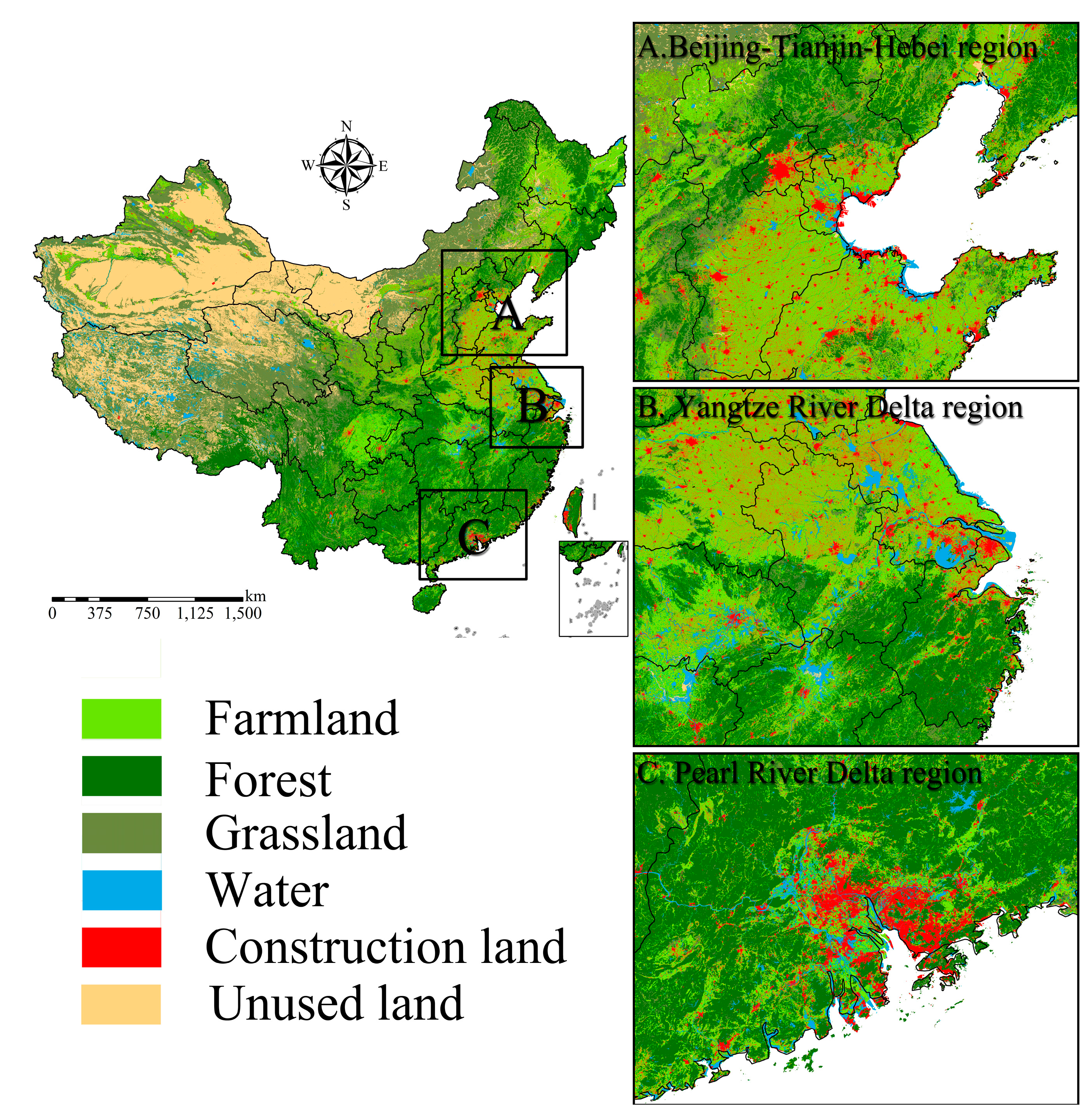
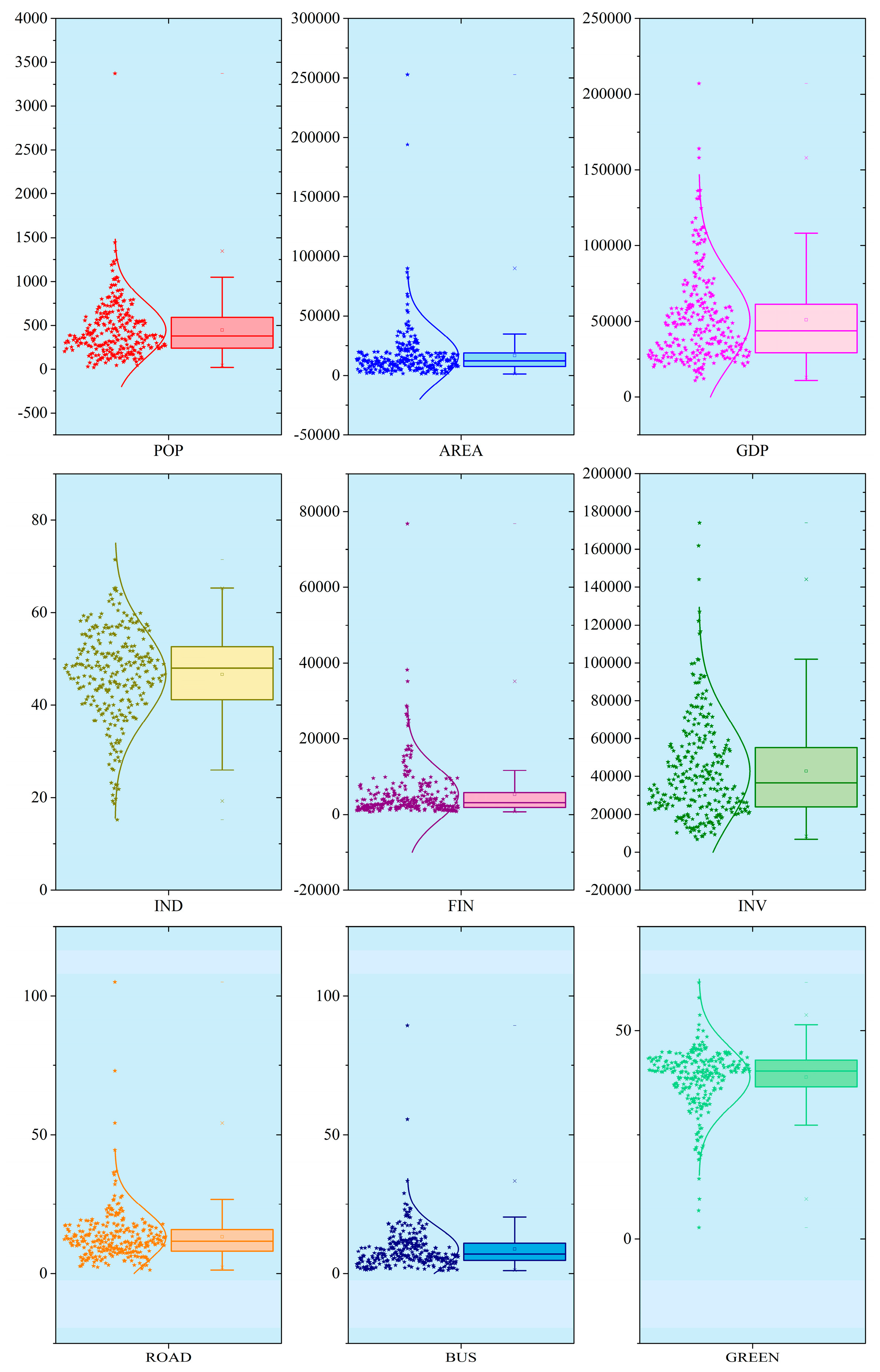

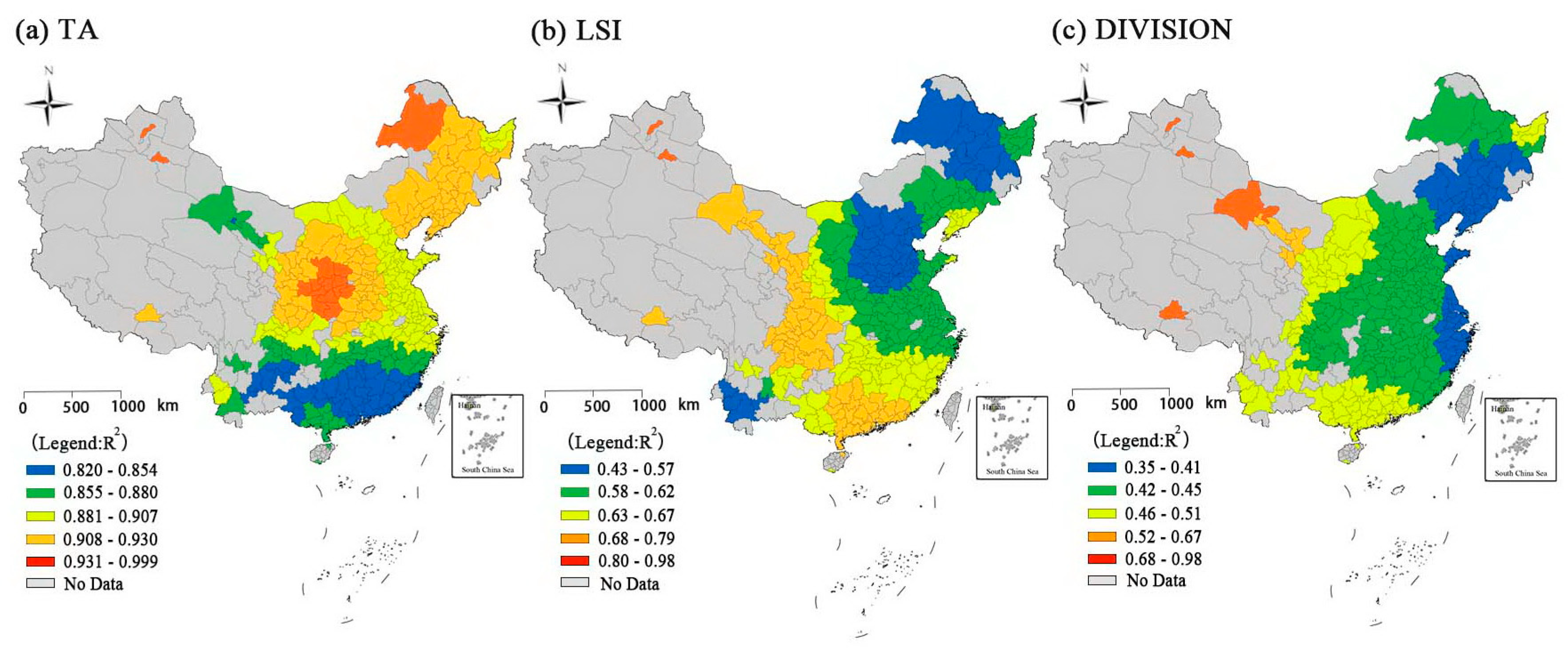
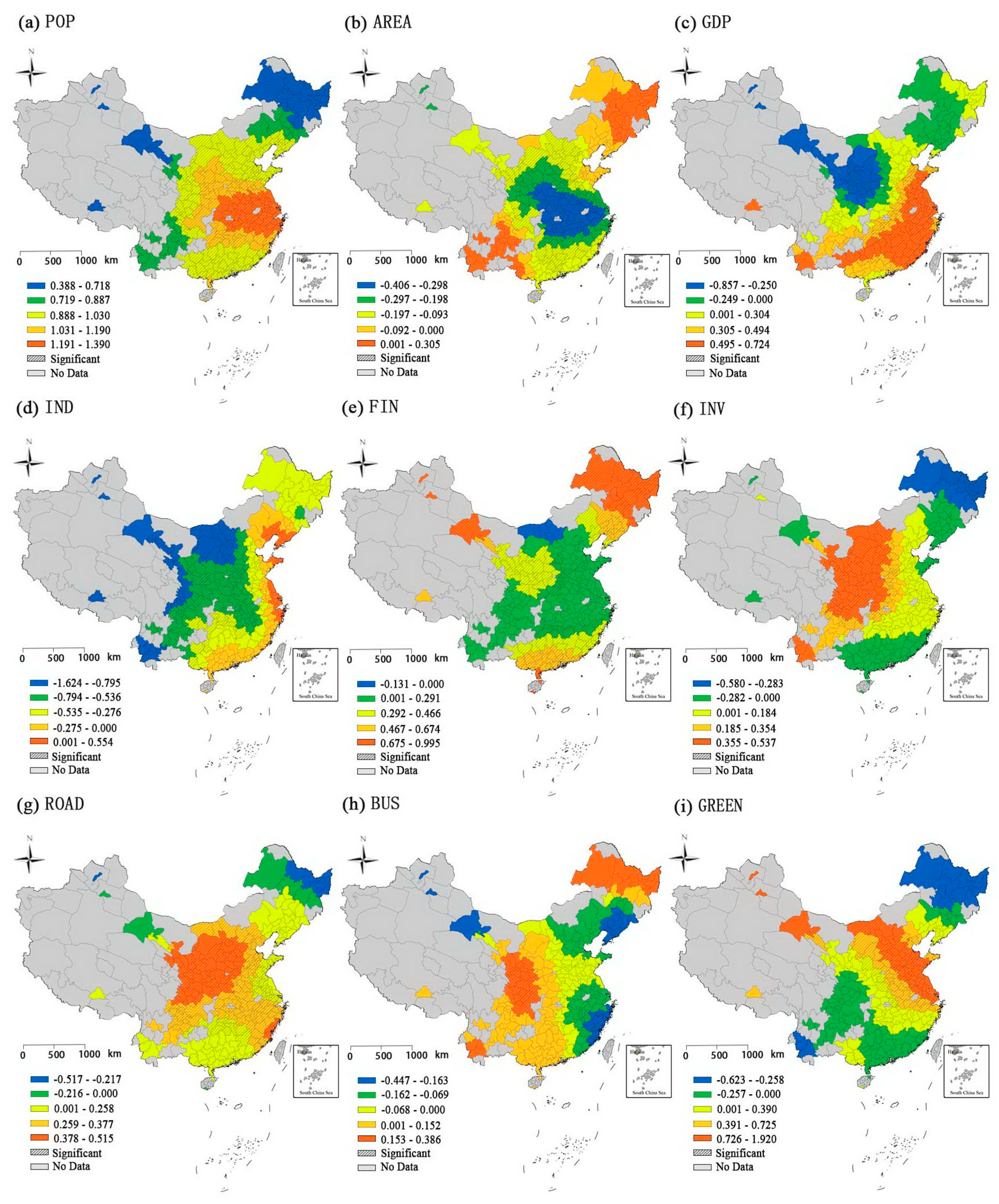
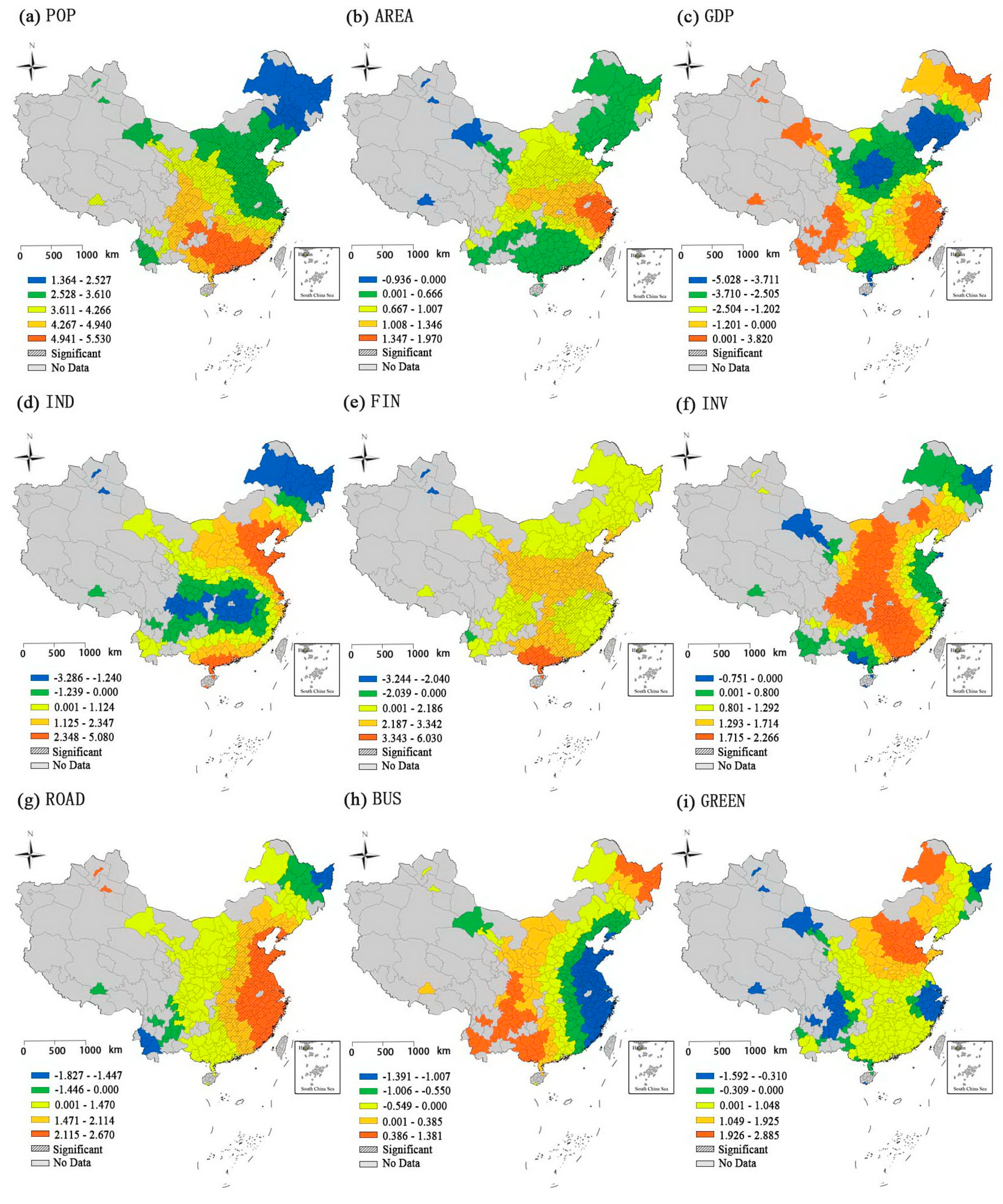
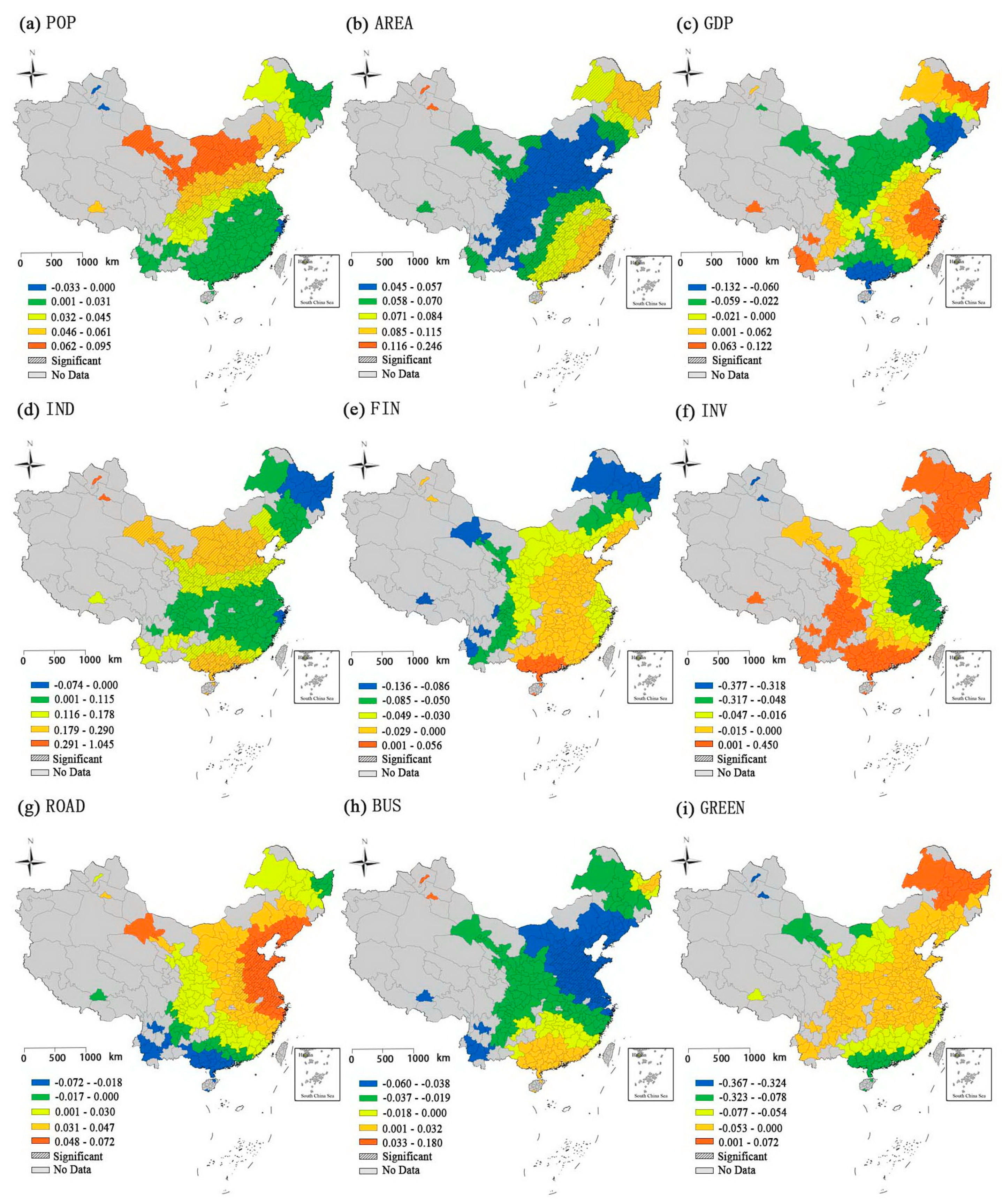
| Landscape Metrics | Equation | Description |
|---|---|---|
| Total landscape area (TA) | aj represents the area of patch j, n refers to the number of patches. | |
| Landscape shape index (LSI) | E* represents total length of edge in landscape, TA refers to the total area of urban land. | |
| Landscape division index (DIVISION) | aij represents the area of patch ij, TA refers to the total area of urban land. |
| Variable Name | Abbreviation | Unit | Mean | Median | Maximum | Minimum | Std. Dev. |
|---|---|---|---|---|---|---|---|
| Total area | TA | ha | 22,767 | 13,391 | 175,075 | 1391 | 24,835 |
| Landscape shape index | LSI | - | 12.70 | 11.85 | 33.80 | 3.59 | 4.83 |
| Landscape division index | DIVISION | - | 0.77 | 0.82 | 0.96 | 0.09 | 0.17 |
| Population | POP | 104 persons | 446.71 | 378.75 | 3371.84 | 20.25 | 318.75 |
| Administrative area | AREA | km2 | 16,563 | 12,236 | 252,777 | 1,201 | 21,735 |
| Per capita gross domestic product | GDP | yuan | 51,049 | 43,853 | 207,163 | 10,987 | 29,487 |
| Industrialization level | IND | % | 46.64 | 48.03 | 71.45 | 15.17 | 9.56 |
| Per capita local financial revenue | FIN | yuan | 5270 | 3097 | 76,815 | 741 | 7006 |
| Per capita fixed investment | INV | yuan | 42,795 | 36,527 | 173,987 | 6799 | 26,634 |
| Per capita urban road area | ROAD | m2 | 13.27 | 11.70 | 105.02 | 1.24 | 9.49 |
| Number of public transport vehicles per 10,000 persons | BUS | unit | 8.85 | 6.94 | 89.34 | 1.04 | 7.78 |
| Green coverage ratio | GREEN | % | 38.82 | 40.32 | 61.58 | 2.71 | 7.24 |
| VIF | Tolerance | |
|---|---|---|
| POP | 1.167 | 0.857 |
| AREA | 1.384 | 0.722 |
| GDP | 6.034 | 0.166 |
| IND | 1.457 | 0.686 |
| FIN | 6.158 | 0.162 |
| INV | 3.977 | 0.251 |
| ROAD | 1.945 | 0.514 |
| BUS | 2.045 | 0.489 |
| GREEN | 1.281 | 0.781 |
| Explanatory Variable | TA | LSI | DIVISION |
|---|---|---|---|
| POP | 99.3%2 | 94.8% | 41.9% |
| (+) | (+) | (+) | |
| AREA | 55.7% | 43.9% | 99.3% |
| - | (+) | (+) | |
| GDP | 44.6% | 26.0% | 0 |
| (+: 88.4%, −: 11.6%) | - | - | |
| IND | 48.1% | 1.7% | 46.0% |
| - | (+) | (+) | |
| FIN | 49.1% | 61.9% | 2.1% |
| (+) | (+) | - | |
| INV | 30.8% | 8.3% | 3.5% |
| (+: 92.1%, −: 7.9%) | (+) | - | |
| ROAD | 68.2% | 51.9% | 23.2% |
| (+) | (+) | (+) | |
| BUS | 11.4% | 21.5% | 26.6% |
| (+:54.5%, −: 45.5%) | - | (+:1.3%, −: 98.7%) | |
| GREEN | 38.4% | 1.7% | 1.0% |
| (+) | (+) | (+) |
© 2019 by the authors. Licensee MDPI, Basel, Switzerland. This article is an open access article distributed under the terms and conditions of the Creative Commons Attribution (CC BY) license (http://creativecommons.org/licenses/by/4.0/).
Share and Cite
Li, S.; Zhou, C.; Wang, S.; Gao, S.; Liu, Z. Spatial Heterogeneity in the Determinants of Urban Form: An Analysis of Chinese Cities with a GWR Approach. Sustainability 2019, 11, 479. https://doi.org/10.3390/su11020479
Li S, Zhou C, Wang S, Gao S, Liu Z. Spatial Heterogeneity in the Determinants of Urban Form: An Analysis of Chinese Cities with a GWR Approach. Sustainability. 2019; 11(2):479. https://doi.org/10.3390/su11020479
Chicago/Turabian StyleLi, Shijie, Chunshan Zhou, Shaojian Wang, Shuang Gao, and Zhitao Liu. 2019. "Spatial Heterogeneity in the Determinants of Urban Form: An Analysis of Chinese Cities with a GWR Approach" Sustainability 11, no. 2: 479. https://doi.org/10.3390/su11020479
APA StyleLi, S., Zhou, C., Wang, S., Gao, S., & Liu, Z. (2019). Spatial Heterogeneity in the Determinants of Urban Form: An Analysis of Chinese Cities with a GWR Approach. Sustainability, 11(2), 479. https://doi.org/10.3390/su11020479






